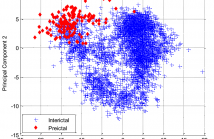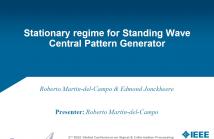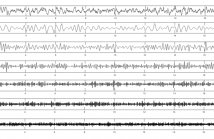
- Read more about Seizure Prediction using Hilbert Huang Transform on Field Programmable Gate Array
- Log in to post comments
The Hilbert Huang Transform (HHT) has been used extensively in the time-frequency analysis of electroencephalography (EEG) signals and Brain-Computer Interfaces. Most studies utilizing the HHT for extracting features in seizure prediction have used intracranial EEG recordings. Invasive implants in the cortex have unknown long term consequences and pose the risk of complications during surgery. This added risk dimension makes them unsuitable for continuous monitoring as would be the requirement in a Body Area Network.
- Categories:
 29 Views
29 Views- Read more about Bird Sounds Classification by Large Scale Acoustic Features and Extreme Learning Machine
- Log in to post comments
- Categories:
 8 Views
8 Views- Read more about Enhancing the Reliability of Epileptic Seizure Alarms for Scalp EEG Signals
- Log in to post comments
- Categories:
 1 Views
1 Views- Read more about The Influence of EM Estimation of Missing Nodes in DCM on Model Ranking)
- Log in to post comments
- Categories:
 4 Views
4 Views
- Read more about Stationary regime for Standing Wave Central Pattern Generator
- Log in to post comments
The purpose of this research is to show that the spatio-temporal analysis on surface Electromyographic (sEMG) signals that originally confirmed existence of a standing wave Central Pattern Generator (CPG) along the spine are reproducible under less than ideal conditions and despite evolution of the entrainment technique, different hardware and data collection protocol. This analysis reveals a coherence at a distance between sEMG signals, which because of its large scale reproducibility could become a test for properly functioning Central Nervous System.
- Categories:
 24 Views
24 Views- Read more about Handling High Level of Censoring For Endovascular Aortic Repair Prediction
- Log in to post comments
- Categories:
 6 Views
6 Views
- Read more about Epileptic focus localization using EEG based on discrete wavelet transform through full-level decomposition
- Log in to post comments
Electroencephalogram (EEG) is a gold standard in epilepsy diagnosis and has been widely studied for epilepsy-related signal classification, such as seizure detection or focus localization. In the past few years, discrete wavelet transform (DWT) has been widely used to analyze epileptic EEG. However, one practical question unanswered is the optimal levels of wavelet decomposition. Deeper DWT can yield a more detailed depiction of signals but it requires substantially more computational time.
- Categories:
 44 Views
44 Views
- Read more about Wireless Body-Area Network Time Synchronization using R Peak Reference Broadcasts
- Log in to post comments
Telemonitoring of biosignals is a growing area of research due to the aging world population. Telemonitoring utilizes a wireless body-area network (WBAN) consisting of wearable biosignal sensors equipped with ultra low power radios. The measured data from each sensor on the patient is sent to a smartphone, which then sends the data to a healthcare provider via the internet. To enable real-time telemonitoring of the biosignals, it is desirable to have accurate timestamped data from the sensors in the WBAN.
- Categories:
 36 Views
36 Views